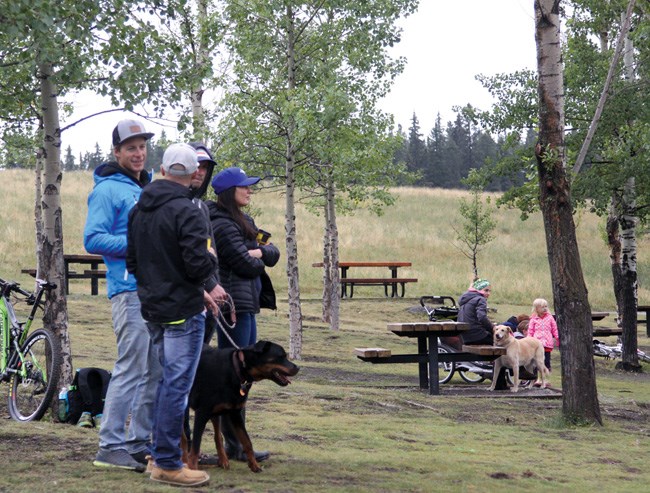CANMORE – Alberta Parks is cracking down on people who have their dogs off leash around Canmore with the hiring of two new rangers who are focusing on education and enforcement.
Officials say the new rangers are out on the trail system on park land around Canmore educating people on how to behave in bear country and dealing swiftly with illegal activity such as dogs off leash, violation of closures and illegal trail building.
Andy Rees, a Bow Valley district conservation officer with Alberta Parks, said having dogs off leash continues to be a major issue, particularly because of how domestic dogs can affect wildlife such as bears.
“We have a zero tolerance on dogs off leash on the park trail system and there will be a $115 fine for doing that,” said Rees, noting subsequent offences can land people a court date with bigger fines and the possibility of banning the dog on Parks land.
“Dogs off leash is an ongoing major issue that we tackle with and we deal with daily. For us it is a serious concern because of the wildlife aspects. You have to have your dog on a leash.”
The two seasonal positions were announced following the release of the Bow Valley human-wildlife coexistence task force’s report, which concluded maintaining and restoring wildlife corridors is a challenge here, especially in the face of increasing human use and expanding development.
The group came up with 28 recommendations to improve habitat security for wildlife, include greater staffing and enforcement, regulating human use, seasonal closures and removal or relocation of trails if they are impediments to wildlife habitat and security.
A two-year remote camera study of human use in wildlife corridors and habitat patches around Canmore between 2015-2017 showed almost 50,000 records of dogs, 58 per cent of which were off leash.
In addition, a recent PhD dissertation analysis by Cheryl Hojnowski found that hikers and, in particular, off-leash dogs are displacing some wildlife around Canmore.
In particular, her research showed off-leash dogs had a negative impact on habitat use of black bears, elk and deer, and hikers were had a negative impact on habitat use of cougars and white-tailed deer.
Hojnowski said that as well as displacing wildlife, dogs may affect wild animals’ physiology and energy expenditures by raising stress levels or increasing flight distances.
“Off-leash dogs move unpredictably and can chase animals, which may lead to ‘sensitization’ of wildlife and increased intensity of responses like avoidance, flight, or stress,” she stated in her report.
“Surprisingly, off-leash dogs did not appear to negatively impact space use of cougars or coyotes in the study area. These two species may be less likely to perceive dogs as a potential predator.”
Hojnowski said land managers seeking to better understand the relationship of dogs and wildlife should consider closing some trails entirely to domestic dogs, and then compare wildlife use of dog-free areas to wildlife use of trails where dogs are allowed.
She also suggested that managers could reduce the effects of recreation by decommissioning trails, particularly unofficial trails within wildlife corridors, or by limiting the number of recreationalists on trails, for example, through a day-use fee system.
While some wildlife species may have been habituated to the presence of humans, Hojnowski said this effect did not extend to off-leash dogs, which displaced most species in her study.
“Since the majority of all dogs on trails in the study area were off-leash – 58.2 per cent – even though leashing is required, off-leash dogs appear to pose a major management challenge,” she said.
“Compliance with leash laws could be increased by increasing enforcement effort, raising fines, developing outreach programs to foster leashing as a community social norm, and better informing the public about the detrimental effects of dogs on wildlife.”




